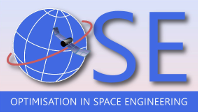List of Abstracts
Juan Carlos Bastante: On the use of Indirect Methods for the optimisation of GTO to GEO chemical propulsion transfers
OHB System, GermanyThe first North-South Station Keeping manoeuvre of a GEO satellite, after injection in its operational orbit, can be delayed up to several months if carefully selecting the initial inclination vector. Since such initialisation of the GEO orbit can imply some propellant cost (depending on the launch date \& time, it might be necessary to command big RAAN changes), adopting this strategy would result in global (transfer + operational) delta-v savings when the first manoeuvre is delayed a long enough period of time, i.e., for a big enough control box.
The talk will present the application of an Indirect Method to solve for the execution of the 4 to 6 burns of a chemical propulsion engine from GTO to GEO, illustrating the links to the operational context and quantifying the potential savings in real scenarios.
Joachim Clemens: Autonomous Subsurface Exploration of the Icy Moon Enceladus
University of Bremen, GermanyRecent evaluations of the data of the Cassini spacecraft provide strong evidence for the existence of liquid water under the ice-covered surface of the Saturnian moon Enceladus. The aim of this talk is to present new technologies for navigating maneuverable melting probes through deep ice in order to collect clean samples from such subglacial water reservoirs and search for extra-terrestrial live. The main focus is on four topics: (a) in-ice localization, which is formulated in terms of a graph optimization problem, (b) parameter identification, (c) optimal trajectory planning, and (d) model-predictive control. We give an overview of our work and present preliminary results.
Bernd Dachwald: Global Optimization of Continuous-Thrust Trajectories Using Evolutionary Neurocontrol
FH Aachen University of Applied Sciences, GermanyFusing artificial neural networks and evolutionary algorithms, evolutionary neurocontrol tackles continuous-thrust trajectory optimization problems not from the perspective of optimal control theory but from that of artificial intelligence and machine learning. Continuous-thrust trajectories can be optimized without an initial guess and without supervision by an expert in astrodynamics and optimal control. For several existing low-thrust problems, it was demonstrated that this method can be used to find near-globally optimal solutions, even for very complex trajectories with many revolutions. Its field of application may be extended to a variety of optimal control problems.
Giorgio Fasano: Spacecraft control dispatch: an advanced optimization approach
Thales Alenia Space, ItalySpacecraft attitude control is notoriously a major issue, entailing the conception of a dedicated on-board system. An appropriate strategy, expressed in terms of total force and torque demand, occurring, step by step, during the whole time span relevant to a baseline mission, represents the operational framework. The control distribution among the available actuators has to be optimized, in order to minimize the overall fuel consumption. A very hard (non-convex) optimization scenario arises, concerning the thruster layout and utilization. This presentation focuses on the topical mathematical modeling and algorithmic aspects, pointing out a global optimization and mathematical programming perspective.
Kathrin Flaßkamp: Motion Planning with Structure-Exploiting Motion Primitives
Universität Bremen, GermanyOptimal control methods for nonlinear systems strongly depend on good initial guesses in order to find locally optimal solutions which are globally efficient. This talk introduces motion planning with motion primitives as an approach to derive admissible solutions to control problems which then serve as sophisticated initial guesses for optimization. Motion primitives are pieces of trajectories that exploit inherent system structures, i.e. symmetry (invariances) and invariant (un)stable manifolds. Motion planning with primitives provide a suitable framework for efficiently designing optimal trajectories during operation of a system, also for multiple optimization criteria.
Bent Fritsche: Minimization of the ground casualty risk due to re-entering spacecraft
Hyperschall Technologie Göttingen, GermanyLarge spacecraft re-entering the Earth atmosphere pose a risk to the population on ground since they do not burn up completely during re-entry. At present many investigations are performed to minimize this risk for future launches by design, either by choosing suitable initial re-entry state vectors, or by selecting less temperature-resistant materials, or by arranging the components within or attached to the spacecraft in an appropriate way. In the presentation examples will be shown for the results of a coupling of a re-entry risk prediction tool with an optimizer to find minimum risk conditions.
Sören Geffken: The upcoming multi-objective interface for WORHP
Universität Bremen, GermanyThis talk focusses on the Multi-Objective Interface for WORHP. Using the WORHP Multi-Core Interface parallelism can straightforwardly be exploited and the scalarised problems are thus solved efficiently. Technical details as well as preliminary results are presented.
Christoph Manß: Entropy Driven Swarm Exploration with several Quadrocopters
Deutsches Zentrum für Luft- und Raumfahrt, GermanyEfficient data processing algorithms for information gathering with multi-agent systems are of paramount importance for future robotic space missions, especially where a high level of autonomy and robustness is expected. This work shows an experiment, where a decentralized learning of a stationary spatial process using a swarm of intelligent agents, has been done last summer.
The spatial process is represented as a linear combination of radial basis functions, called features, such that a splitting-over-features distributed learning with a sparse Bayesian learning technique can be applied to estimate the weights of individual features and identify relevant model features using sparsity techniques.
Vola Maria Chiara: Nonlinear regression analysis in space engineering: a global optimization approach
Altran Italy, ItalyModel fitting to observational data plays an important role in space engineering. Traditionally, local optimization techniques have been applied to solve nonlinear calibration problems. The limitations of such approaches are, nonetheless, well known. Global optimization strategies can be used, as a profitable alternative. This work discusses the case of a scientific instrument, installed on board the International Space Station and aimed at studying the Sun’s effect on the Earth’s atmosphere. The mathematical model is illustrated with the computational results, obtained with the LGO solver. This study shows the robust and efficient performance of the global scope model calibration approach.
Alessandro Peloni: ATOSS: Automated Trajectory Optimiser for Solar Sailing
University of Glasgow, United KingdomThis talk presents an automated toolbox for multi-leg solar-sail trajectories. ATOSS uses a pseudospectral method together with a shape-based approach. Two continuations are implemented to help the convergence of the optimiser: one on the dynamics and a second one on the flight time. Each optimisation problem is solved by means of GPOPS-II, which is interfaced with IPOPT, SNOPT and WORHP. A study on single and multiple NEA rendezvous missions proved the robustness of ATOSS. Moreover, ATOSS requires minimum external input and, therefore, it is suitable for preliminary mission design involving a large number of mission options.
Christopher John Price: Stochastic filter methods for global optimization
Mathematics and Statistics, New ZealandThis talk looks at variants of Accelerated Random Search (ARS) for black box global optimization of non-smooth functions subject to finite simple bounds on all variables. A variation (OSCARS) is presented which outperforms ARS and a similar deterministic algorithm. OSCARS can also be adapted to generally constrained global problems via a filter approach. This approach is shown to be effective in practice on Michalewicz' test set. The filter approach is easily adapted to many underlying global optimization methods other than OSCARS.
Dominik Quantius: Parameter Analysis of a Concurrent Engineering Satellite Study
DLR, GermanyAim of this talk is the analysis of the design parameter space, i.e. the amount of used parameters and their interdependencies observed during the SolmeX Concurrent Engineering (CE) study, a Sun observation satellite mission, which was conducted by the DLR Institute of Space Systems in Bremen. In total a number of 406 parameters have been detected including 9531 interconnections. By the help of the graph theory the structure of those parameters is elaborated counting their vertices and nodes. It builds the basis for the development of a generic design analysis and optimization tool for the CE data model.
Annalisa Riccardi: Uncertainty based Multidisciplinary Design Optimisation
University of Strathclyde, UKThe design of complex systems is inherently multidisciplinary, as several disciplines must be taken into account. What has changed during the last decades is the level of interaction among the disciplines, which is exploited to obtain a faster design process and an optimal configuration, having optimal performance in real operational conditions. Multidisciplinary Design Optimisation (MDO) emerged as a new approach providing a set of methods and tools to help engineers in the design of system for which the whole is greater than the sum of the parts. In the common formulation MDO does not necessarily mean that uncertainties are considered during the design process. When this happens we refer to it as Uncertainty-based Multidisciplinary Design Optimization (UMDO).
This presentation addresses the integrated design of system and mission{}/{}process control under uncertainty developed and currently used that Dept. of Mechanical \& Aerospace Engineering of the University of Strathclyde. The main aspects of the approach are detailed and some test cases are shown.
Lorenzo Ricciardi: Multi-objective Optimisation and Multi-objective Optimal Control of Space Systems
University of Strathclyde, United KingdomThis talk will introduce multi-objective optimisation and multi-objective optimal control, and why they are important in space applications. The Multi Agent Collaborative Search algorithm (MACS), a memetic algorithm to solve global multi-objective optimisation problems, will be illustrated and the solutions it provides to some space related problems will be presented.
Then it will be shown that combining MACS with DFET, a direct transcription method for the solution of optimal control problems, it is possible to tackle multi-objective optimal control problems both locally and globally. Examples coming from space related problems will be shown also in this case.
Jan-J. Rückmann: On proper efficiency in multiobjective semi-infinite optimization
University of Bergen, NorwayWe consider multiobjective semi-infinite optimization problems which are defined by finitely many objective functions and infinitely many inequality constraints in a finite-dimensional space. We discuss constraint qualifications as well as necessary and sufficient conditions for locally weakly efficient solutions. Furthermore, we generalize two concepts of properly efficient solutions to the semi-infinite setting and present corresponding optimality conditions.
Anne Schattel: Trajectory Optimization for Autonomous Deep Space Asteroid Missions within the project KaNaRiA
Universität Bremen, GermanyThis talk focuses on trajectory optimization for autonomous deep space small celestial body missions, including cruise flight, proximity operations, and landing. The transcription of respective optimal control problems into nonlinear optimization problems is introduced and different solutions are presented. Additionally, the use of parametric sensitivity analysis for stability and perturbation analysis of optimal solutions is explained.
Celia Yabar Valles: Optimisation for space applications at ESA
ESA, NetherlandsOptimisation is indispensable for many different aspects of any space mission such as mission analysis, trajectory planning, system design and payload performace. Moreover, space missions are continuosly becoming more complex, requiring the solution of increasingly hard optimisation problems.
The aim of this talk is to show that the collaboration between ESA, industry and academia is essential to continue innovating, regarding both theoretical advances and ready-to-use tools for actual space applications. First, a brief introduction of ESA and the GNC section will be presented, followed by the optimisation challenges in current and future ESA space missions. Afterwards, some optimisation techniques developed and used by the GNC section will be shown. Finally, a summary on the ESA industrial policy and possible technology research and development collaboration programs will be explained.






